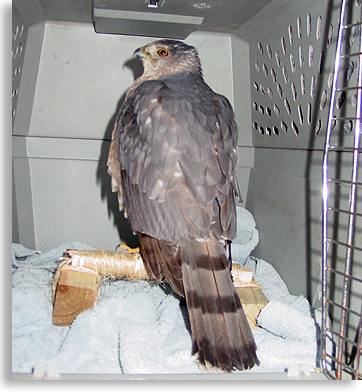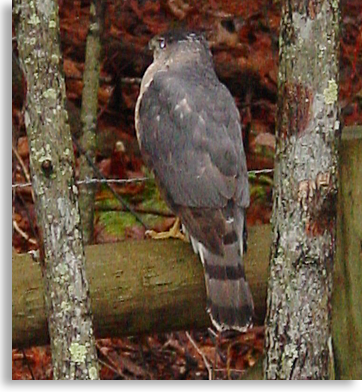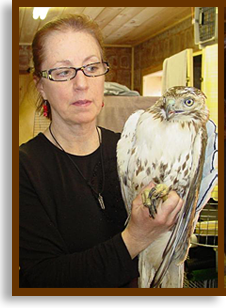Day in the Life of a Local Wildlife Rehabilitator
by Liz Nicholas
It was a Sunday evening in March around 6:30 pm; I received a call, the Caller ID read "Fannin Regional Hosp." I immediately worried about who could be calling me from the hospital? The voice on the other end said "ah, hi there, I got your number from the emergency clinic, and I wondered if you could help me."
Instantly, I thought, why is someone calling ME from the emergency clinic for help? Did they need help identifying a poisonous snake that bit someone? Not likely since snakes are not really active yet, it's still too cold. The next thought was, oh no, one of my friends had been in an accident.
She went on..."we have a Falcon that flew into the window at the hospital and it's just lying here. We have been trying to find someone for hours that is allowed to take this bird." I was slightly relieved, "oh, ok.... I can come right away. I am a licensed wildlife rehabilitator who handles federally protected species. You are only a few minutes from me, let me find my leather gloves and get a crate in the car and I will be on my way. Is there someone staying with the animal so I’ll know where to find you?" She said; "yes, we will be standing on the side of the hospital near the heliport."
I arrived in about 7 minutes and saw a group of people in scrubs standing in the cold air, without coats, all-waiving. Two men in medical jump suits and two nurses were there to greet me. Instantly I saw the bird, face down, not moving. Someone pointed out where it had the collision with the blacked/reflective window on the building - there were a lot of scuff marks, a white powder imprint on the window and feathers lying around.
I knelt down and put my hands around the bird's bluish body, wings folded into his sides already. As soon as I turned it over I knew it was a Cooper’s Hawk. These hawks have a purple color inside of their mouths. I also knew it was not a good sign. Finding any bird "face down" and lifeless most often indicates severe trauma. One of the nurses told me she came outside to protect it from the crows that were dive-bombing it.
I did a quick examination to see if/how the bird was breathing. There was little, to no response. Eyes closed, mouth open, slow and few breathes, lifeless legs, claws/talons limp and closed. I was worried this is NOT a good sign. In seconds it felt like the temperature dropped 20 degrees, as now a half dozen nurses and doctors were gathered around and very concerned.
I told them what kind of bird it was, and that it was probably going after his last meal of the day, when it hit the window. I thanked them for calling me and told the nurse that I would get back to her to gather information for the paperwork. My first priority was to get home to help the hawk. There was a huge storm-front coming and we all knew the bird’s chance of making it outdoors that night was about zero. No one said anything more. The mood was somber.
I rolled up a towel, place the bird upright in the makeshift nest supporting its head and neck, put it in the crate for transport, and headed out. I estimated the bird was now about 2-3 hours post impact, and held little chance of recovering. If it couldn’t make it, the least I could do is give it a peaceful passing in a quiet, warm and stress free environment.
The storm of the century came. We lost power, which made it extremely difficult to navigate in my rehab intake area. I was able to create a makeshift exam light from my flashlight, and administer oral anti-inflammatory medication, IM fluids into its thighs, as well as a Vitamin B injection into it's right breast. I quickly felt for possible wing fractures and there seemed to be none. Unfortunately, I saw no reaction at all during the exam. I made the bird as comfortable as possible and decided not to bother it again until the morning.
Day 1: Around 6:00 am Monday morning, electricity was on, at least that was good. I opened the door to my rehab/recovery room. I dreaded going in there what a way to start the week if the hawk had died overnight. I have been trained not get emotionally attached to our patients, but that isn’t always easy. It can be taxing because of the "human element" attached to the animal; as a rescuer, I always try to have hope that my actions did some good, and hopefully save their life. It's never easy to tell someone that his or her animal did not make it.
 Much to my total surprise I found the hawk standing! At first I couldn’t see its head, and thought that perhaps it sustained a broken neck. Much to my total surprise I found the hawk standing! At first I couldn’t see its head, and thought that perhaps it sustained a broken neck.
I said; "buddy are you there?" I quickly realized its head was tucked under its wing. I was shocked and extremely pleased to say the least. I had given this bird less than a 1% chance to make it through the night and here it is standing!
Wrapping its body in a towel like a taco, I began to hand feed it two small "thawed-out and warmed-up mice" doused in fluids and medication. I know, gross huh - but like I tell most people that express an interest in doing what I do, if you can't put a mouse in a blender, tending to wildlife is not for you. She was cooperative and ate them both with little to no resistance.
I put her back in the crate until that evening. I checked on her again around 6:30 and gave her a second round of medication and a small amount of oral fluids. She’s now showing even more signs of life, got a little "fight in-er." By now, I decided it was a "she" because of her snippy attitude and her size - females are usually bigger than males. She is not out of the woods yet.
A Coopers Hawks aka Accipiter Cooperii, is one of the most challenging to have in recovering captivity, post injury. Rehab is very stressful for them as well as their handler. They are typically extremely high strung, uncooperative and defensive until the end. Tell any "Bird of Prey" rehabber or Falconer you have a Coppers Hawk and they will say "Oh, I'm am sorry!"
Day 2: Still flat footed in her cage and not perching. She had not eaten the food I left the night before either, so I knew that I would have to muscle her; (term for wrapping her again like a taco), and force-feed and medicate.
This time, there was a huge difference in her demeanor. She was using her feet and talons to slice me like the Christmas ham, it was an all out battle! This is the moment I decided to name her Stormy and I felt that she had a chance to make it by some miracle!
Gloves on, confident in my actions, I got her safely contained, wrapped and medicated. I could see that her wings were fully extended as I grabbed her, again. I saw no wing or pelvic injuries, which was good.
She was acting EVERY bit like a very angry Coopers Hawk. Now one more huge hurdle to overcome, she needed to perch or I would have to take her to the vet to help me make the hard decision; that her neurological damage was too extensive to release her. With these birds, there is a delicate balance on exactly how long you can keep them in captivity before they start to do extensive damage to themselves and their plumage as a result of thrashing within the containment.
Day 3: Wednesday morning, 7am. I slowly peeked in Stormy's enclosure. She was sound asleep with her head tucked under her wing but... she was on the perch! She was grasping and holding on like a champ! And all the food I left the night before was gone.
Much to my surprise, there was AMAZING progress in only three days. Her demeanor had changed back to the bird she was before our chance meeting, and she told me by her body language and dismay at my loving and cautious eyes, that today was to be her liberation day.
 At 9:30 that same morning, I took her crate to my upper side porch and opened it. She immediately flew to the fence line. Looking around, Stormy heard the songbirds chirping and in about a minute, she took the most beautiful flight about 100 feet into a stand of pine trees. At 9:30 that same morning, I took her crate to my upper side porch and opened it. She immediately flew to the fence line. Looking around, Stormy heard the songbirds chirping and in about a minute, she took the most beautiful flight about 100 feet into a stand of pine trees.
We do our best to return injured "Bird’s of Prey" back to their home range, which is within a mile for a few reasons.
First, adult birds might have a mate and family they need to re-join.
Second, nature has something called a "carrying capacity” which essentially equates to a fine balance of all species in which it can support.
You shouldn't relocate ANY SPECIES. 1. It's often illegal to do so. 2. It's usually not successful; less than 20% of relocated wildlife will survive. When you release any animal not from that area into a given habitat that they are not familiar with, you basically cause an imbalance in the entire natural community of animals that live there, regardless of the species. The best example I can give off-hand are people that are adamant about removing certain mammals they consider a nuance, such as fox and coyotes. When these animals are removed, it usually causes an overabundance of rats for the first year, and then an increase in the population of that same animal you removed the following year. Nature has a way of balancing the gap of the species that were removed. Ask any wildlife biologist about relocation. It's a sore subject.
For Stormy, since I lived within that footprint of the hospital, it was the perfect release location for her and less stressful, because I didn’t have to put her in the car to transport before her release.
In the end, looking back, I can definitely say that I learned a lot from this bird. I learned to never give up, no matter how hopeless it might seem. I learned how to identify signs of stress, trauma and recovery in a bird most licensed rehabbers would cringe to take in. I learned how good-hearted our community is, as so many medical personnel were very concerned about this beautiful bird, that just happened to select the wrong path in her flight to find food. I also learned that there is a spiritual nature to these animals, and intuitively for me, I needed to listen to my little voice inside as to when it is time to help, and when it is time to let them go.
People continue to ask me why we "licensed rehabbers" intervene with nature? Especially in this case of a bird that was almost clinically dead. In the case of this one bird it made all the difference in the world. It's not her fault that there was a big black shiny, reflective, hard barrier in her way.
Even though we are licensed under the Department of Natural Resources and US Fish & Wildlife Service, we tend to wildlife at our own expense. In this particular instance, this hawk, unlike some of my other charges, was not a huge expense to my personal pocketbook. Stormy cost me about 60 hours of my time, a little gas in my car, and about $35 in medication and food.
She gave me an awful lot more in return. I know a lot more about the treatment of head trauma injuries. I know that people care. I know I made a difference in this bird’s life. It was worth every minute and every dime.
It gave me hope and reinforced my belief that I was making a difference in my own little wild world within the North Georgia Mountains. And, it gave the nurses and doctors of Fannin Regional Hospital that found her, the satisfaction that because of their actions, they saved a very precious and worthy life that just happened to have feathers.
If you would like to schedule Liz for an educational outreach program, e-mail her at info@liznicholas.com. You can also make a donation to Liz’s Wildlife Fund, by contacting the clinic directly at 706-946-7387 by donating to her project using this link: http://www.indiegogo.com/helpbuildabirdofpreycage
Liz is also reachable, along with other wildlife rehabbers under the "find a rehabilitator" at the DNR website: www.georgiawildlife.org
|

 Much to my total surprise I found the hawk standing! At first I couldn’t see its head, and thought that perhaps it sustained a broken neck.
Much to my total surprise I found the hawk standing! At first I couldn’t see its head, and thought that perhaps it sustained a broken neck.  At 9:30 that same morning, I took her crate to my upper side porch and opened it. She immediately flew to the fence line. Looking around, Stormy heard the songbirds chirping and in about a minute, she took the most beautiful flight about 100 feet into a stand of pine trees.
At 9:30 that same morning, I took her crate to my upper side porch and opened it. She immediately flew to the fence line. Looking around, Stormy heard the songbirds chirping and in about a minute, she took the most beautiful flight about 100 feet into a stand of pine trees. 

